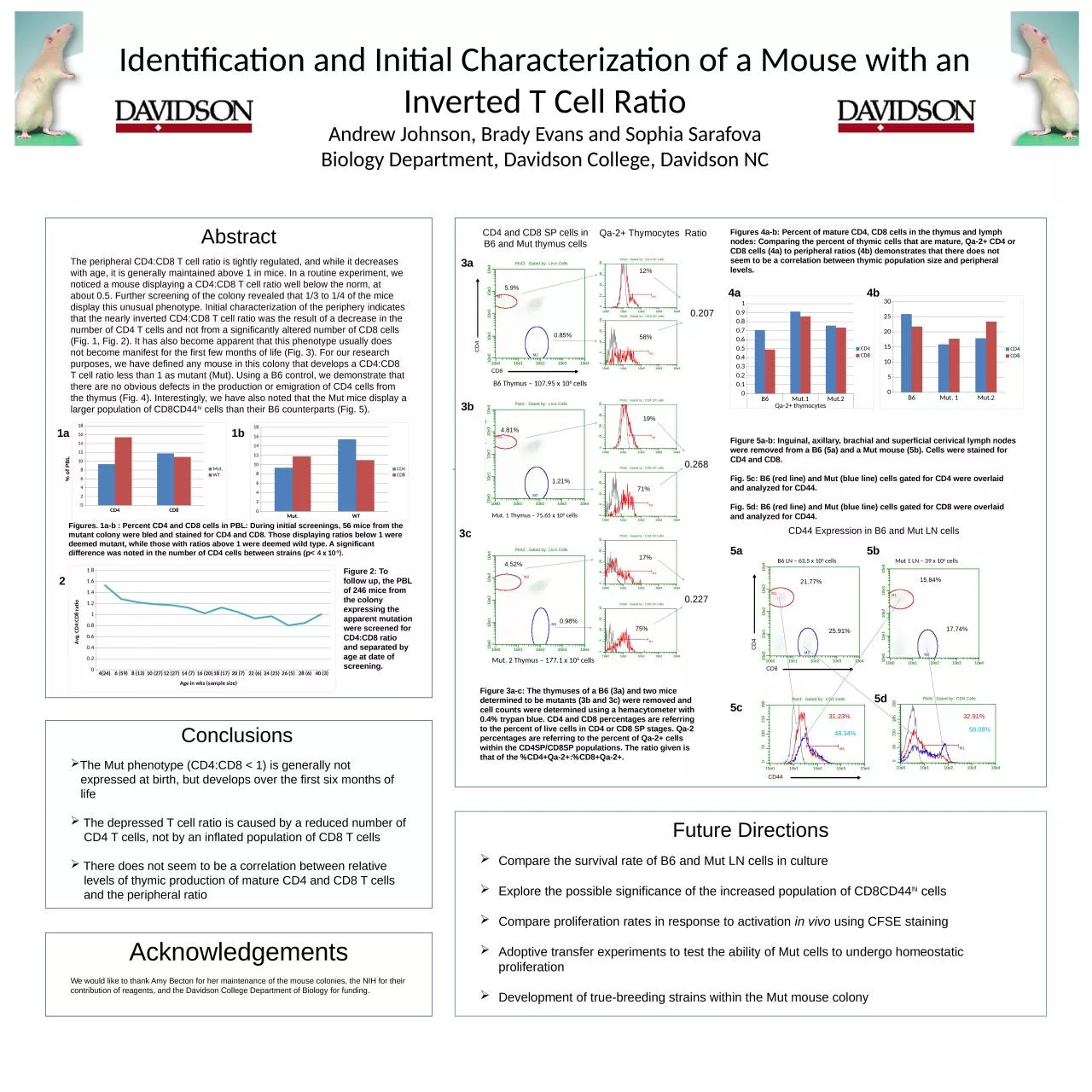

Andrew Johnson Brady Evans and Sophia Sarafova Biology Department Davidson College Davidson NC B6 Thymus 10795 x 10 6 cells Mut 1 Thymus 7565 x 10 6 cells Mut 2 Thymus 1771 x 10 ID: 930528
Download Presentation The PPT/PDF document "Identification and Initial Characterizat..." is the property of its rightful owner. Permission is granted to download and print the materials on this web site for personal, non-commercial use only, and to display it on your personal computer provided you do not modify the materials and that you retain all copyright notices contained in the materials. By downloading content from our website, you accept the terms of this agreement.
Slide1
Identification and Initial Characterization of a Mouse with an Inverted T Cell Ratio
Andrew Johnson, Brady Evans and Sophia SarafovaBiology Department, Davidson College, Davidson NC
B6 Thymus – 107.95 x 10
6
cells
Mut. 1 Thymus – 75.65 x 10
6
cells
Mut. 2 Thymus – 177.1 x 10
6
cells
CD44 Expression in B6 and Mut LN cells
Conclusions
Qa-2+ Thymocytes
Abstract
The peripheral CD4:CD8 T cell ratio is tightly regulated, and while it decreases with age, it is generally maintained above 1 in mice. In a routine experiment, we noticed a mouse displaying a CD4:CD8 T cell ratio well below the norm, at about 0.5. Further screening of the colony revealed that 1/3 to 1/4 of the mice display this
unusual
phenotype. Initial characterization of the periphery indicates that the nearly inverted CD4:CD8 T cell ratio was the result of a decrease in the number of CD4 T cells and not from a significantly altered number of CD8 cells (Fig. 1, Fig. 2).
It has also become apparent that this phenotype usually does not become manifest for the first few months of life (Fig. 3). For our research purposes, we have defined any mouse in this colony that develops a CD4:CD8 T cell ratio less than 1 as mutant (Mut). Using a B6 control, we
demonstrate that there are no obvious defects in the production or emigration of CD4 cells from the
thymus (Fig. 4). Interestingly, we have also noted that the Mut mice display a larger population of CD8CD44
hi cells than their B6 counterparts (Fig. 5).
5.9%
0.85%
4.81%
1.21%
4.52%
0.98%
12%
58%
19%
71%
17%
75%
CD4 and CD8
SP cells in B6 and Mut thymus cells
1a
1b
Future
Directions
Acknowledgements
CD8
CD4
2
3a
3b
3c
4a
4b
Figure 3a-c: The thymuses of a B6 (3a) and two mice determined to be mutants (3b and 3c) were removed and cell counts were determined using a hemacytometer with 0.4% trypan blue. CD4 and CD8 percentages are referring to the percent of live cells in CD4 or CD8 SP stages. Qa-2 percentages are referring to the percent of Qa-2+ cells within the CD4SP/CD8SP populations. The ratio given is that of the %CD4+Qa-2+:%CD8+Qa-2+.
CD8
CD4
CD44
5a
5c
5d
Compare the survival rate of B6 and Mut LN cells in culture
Explore the possible significance of the increased population of CD8CD44
hi
cells
Compare proliferation rates in response to activation
in vivo
using CFSE staining
Adoptive transfer experiments to test the ability of Mut cells to undergo homeostatic proliferation
Development of true-breeding strains within the Mut mouse colony
Figures. 1a-b : Percent CD4 and CD8 cells in PBL: During initial screenings, 56 mice from the mutant colony were bled and stained for CD4 and CD8. Those displaying ratios below 1 were deemed mutant, while those with ratios above 1 were deemed wild type. A significant difference was noted in the number of CD4 cells between strains (p<
4 x 10
-5
).
We would like to thank Amy Becton for her maintenance of the mouse colonies, the NIH for their contribution of reagents, and the Davidson College Department of Biology for funding.
The Mut phenotype (CD4:CD8 < 1) is generally not
expressed at birth, but develops over the first six months of
life
The depressed T cell ratio is caused by a reduced number of
CD4 T cells, not by an inflated population of CD8 T cells
There does not seem to be a correlation between relative
levels of thymic production of mature CD4 and CD8 T cells and the peripheral ratio
21.77%
25.91%
15.84%
17.74%
31.23%
48.34%
32.91%
58.08%
Figure 2: To follow up, the PBL of 246 mice from the colony expressing the apparent mutation were screened for CD4:CD8 ratio and separated by age at date of screening.
Figure 5a-b: Inguinal, axillary, brachial and superficial cerivical lymph nodes were removed from a B6 (5a) and a
Mut
mouse (5b). Cells were stained for CD4 and CD8.
Fig. 5c: B6 (red line) and Mut (blue line) cells gated for CD4 were overlaid and analyzed for CD44.
Fig. 5d: B6 (red line) and Mut (blue line) cells gated for CD8 were overlaid and analyzed for CD44.
Ratio
Figures 4a-b: Percent of mature CD4, CD8 cells in the thymus and lymph nodes: Comparing the percent of thymic cells that are mature, Qa-2+ CD4 or CD8 cells (4a) to peripheral ratios (4b) demonstrates that there does not seem to be a correlation between thymic population size and peripheral levels.
0.207
0.268
0.227
5b
% of PBL
B6 LN – 63.5 x 10
6
cells
Mut 1 LN – 39 x 10
6
cells